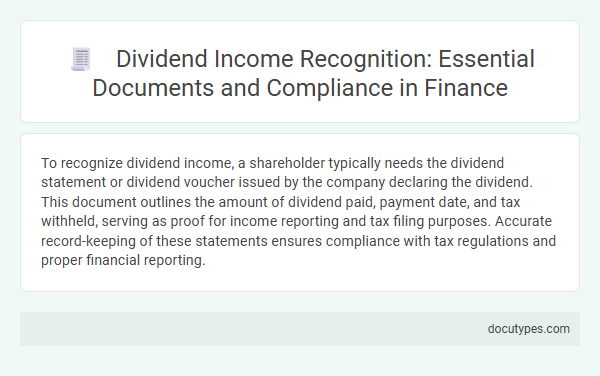To recognize dividend income, a shareholder typically needs the dividend statement or dividend voucher issued by the company declaring the dividend. This document outlines the amount of dividend paid, payment date, and tax withheld, serving as proof for income reporting and tax filing purposes. Accurate record-keeping of these statements ensures compliance with tax regulations and proper financial reporting.
Introduction to Dividend Income Recognition
Recognizing dividend income is a crucial aspect of financial accounting and investment analysis. To accurately record dividend income, the primary document required is the dividend statement or dividend voucher issued by the company paying the dividend. This document provides essential details such as the dividend amount, payment date, and shareholder information, ensuring precise income recognition and compliance with accounting standards.
Key Financial Documents for Dividend Reporting
Recognizing dividend income requires specific financial documents that accurately reflect dividend declarations and payments. Proper documentation ensures compliance with accounting standards and tax regulations.
- Dividend Voucher - A document issued by the company confirming the dividend payment amount and date.
- Bank Statement - Records the actual receipt of dividend funds in the investor's account.
- Dividend Declaration Statement - Details the board's approval and dividend payout schedule.
These key financial documents collectively provide verifiable evidence for recognizing and reporting dividend income correctly.
Regulatory Compliance in Dividend Recognition
Recognizing dividend income requires proper documentation to ensure regulatory compliance and accurate financial reporting. The primary document needed is the dividend declaration statement issued by the company's board of directors, confirming the dividend amount and payment date.
Tax authorities often mandate maintaining records such as dividend vouchers or payment advices that detail the recipient's information and tax withheld. Compliance with regulations like Generally Accepted Accounting Principles (GAAP) or International Financial Reporting Standards (IFRS) necessitates retaining these documents for audit and verification purposes.
Documentation Requirements for Dividend Income
| Document Type | Description | Purpose | Issuer |
|---|---|---|---|
| Dividend Statement | Official statement detailing dividend payments received during a fiscal period. | Serves as proof of dividend income for tax reporting and record-keeping. | Corporation or mutual fund paying the dividend |
| Form 1099-DIV | IRS tax form that reports dividends and distributions to investors in the US. | Used to accurately report dividend income on the individual or corporate tax return. | Brokerage firms, financial institutions, or mutual funds |
| Annual Tax Statements | Consolidated financial summaries including dividend income among other earnings. | Ensures comprehensive income reporting for taxation purposes. | Financial institutions or investment brokers |
| Dividend Vouchers | Payment slips or vouchers received at the time of dividend transaction. | Supports verification of dividend amount received per transaction. | Issuing company or custodian bank |
| Brokerage Account Statements | Monthly or quarterly statements showing realized dividend income. | Used for reconciling dividends received and financial record accuracy. | Brokerage firms or online trading platforms |
Tax Implications of Dividend Income
Recognizing dividend income requires specific documentation to ensure accurate tax reporting and compliance. Properly documenting dividends helps in understanding your tax obligations and potential liabilities.
- Form 1099-DIV - This document reports the amount of dividends paid to shareholders during the tax year.
- Brokerage Statements - Detailed statements from your broker provide confirmation and breakdown of dividend income received.
- Dividend Reinvestment Plan (DRIP) Records - These records track reinvested dividends, affecting taxable income calculations.
Recording Dividend Income in Financial Statements
Proper documentation is essential for accurately recognizing dividend income in financial statements. The main document required is the dividend declaration notice issued by the issuing company.
Recording dividend income requires verification of the declaration date, amount, and payment status to ensure accurate financial reporting.
- Dividend Declaration Notice - Official document from the issuing company stating dividend amount and declaration date.
- Dividend Payment Statement - Confirmation of dividend payment, including date and paid amount.
- Brokerage or Custodian Statements - Records showing receipt of dividends into the investor's account for reconciliation.
Best Practices for Dividend Document Management
Recognizing dividend income requires accurate documentation such as dividend vouchers, broker statements, or official dividend notices issued by the company. Best practices for dividend document management include organizing files by date and source, ensuring digital backups, and regularly reconciling dividend records with brokerage accounts to prevent discrepancies. Maintaining clear and accessible documents supports efficient tax reporting and compliance with financial regulations.
Auditing Dividend Income: Essential Papers
Auditing dividend income requires specific documentation to ensure accuracy and compliance. The primary document is the dividend statement issued by the corporation to its shareholders, detailing the dividend amount and payment date.
In addition, broker statements or account summaries serve as proof of dividend receipt in your financial records. These papers validate the recorded income and facilitate transparent auditing processes.
Common Compliance Challenges in Dividend Recognition
What document is required for recognizing dividend income in your financial records? The primary document needed is the dividend statement or dividend voucher issued by the company declaring the dividend. This statement includes critical details such as the date of declaration, amount per share, and payment date, which are essential for accurate dividend income recognition.
What are the common compliance challenges faced during dividend income recognition? Challenges often arise from discrepancies in dividend declaration dates and payment records, leading to timing issues in recognition. Ensuring the proper documentation and verifying the authenticity of dividend vouchers helps mitigate risks of non-compliance and inaccurate financial reporting.
What Document Is Required for Recognizing Dividend Income? Infographic

